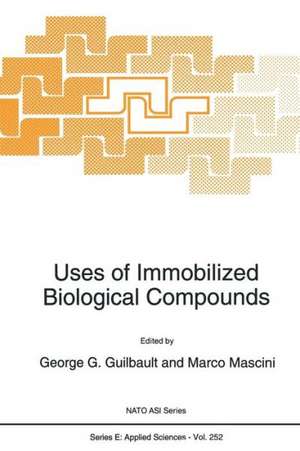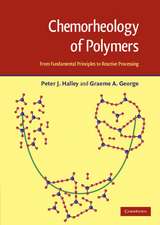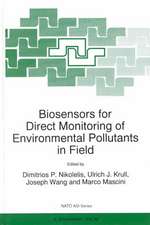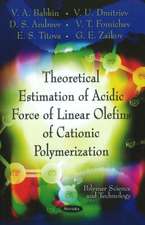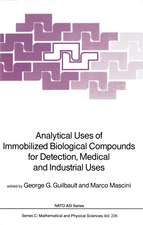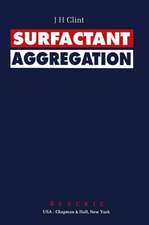Uses of Immobilized Biological Compounds: NATO Science Series E:, cartea 252
Editat de George G. Guilbault, Marco Mascinien Limba Engleză Paperback – 20 oct 2012
Din seria NATO Science Series E:
- 24%
 Preț: 1570.65 lei
Preț: 1570.65 lei -
 Preț: 397.76 lei
Preț: 397.76 lei -
 Preț: 386.81 lei
Preț: 386.81 lei - 20%
 Preț: 346.24 lei
Preț: 346.24 lei -
 Preț: 424.33 lei
Preț: 424.33 lei - 18%
 Preț: 1224.18 lei
Preț: 1224.18 lei - 18%
 Preț: 1836.63 lei
Preț: 1836.63 lei - 18%
 Preț: 1229.28 lei
Preț: 1229.28 lei -
 Preț: 381.00 lei
Preț: 381.00 lei -
 Preț: 409.30 lei
Preț: 409.30 lei - 18%
 Preț: 1841.36 lei
Preț: 1841.36 lei - 5%
 Preț: 367.28 lei
Preț: 367.28 lei -
 Preț: 407.19 lei
Preț: 407.19 lei - 18%
 Preț: 1838.38 lei
Preț: 1838.38 lei -
 Preț: 420.28 lei
Preț: 420.28 lei -
 Preț: 399.29 lei
Preț: 399.29 lei -
 Preț: 398.74 lei
Preț: 398.74 lei - 18%
 Preț: 3026.13 lei
Preț: 3026.13 lei -
 Preț: 388.90 lei
Preț: 388.90 lei - 5%
 Preț: 391.06 lei
Preț: 391.06 lei - 18%
 Preț: 1228.62 lei
Preț: 1228.62 lei - 18%
 Preț: 1229.73 lei
Preț: 1229.73 lei - 18%
 Preț: 1234.46 lei
Preț: 1234.46 lei - 5%
 Preț: 3532.05 lei
Preț: 3532.05 lei - 18%
 Preț: 1840.11 lei
Preț: 1840.11 lei - 5%
 Preț: 378.80 lei
Preț: 378.80 lei - 18%
 Preț: 1227.84 lei
Preț: 1227.84 lei -
 Preț: 392.75 lei
Preț: 392.75 lei -
 Preț: 395.63 lei
Preț: 395.63 lei - 18%
 Preț: 2489.30 lei
Preț: 2489.30 lei - 5%
 Preț: 1429.27 lei
Preț: 1429.27 lei -
 Preț: 396.02 lei
Preț: 396.02 lei - 5%
 Preț: 2142.61 lei
Preț: 2142.61 lei - 18%
 Preț: 3049.16 lei
Preț: 3049.16 lei - 18%
 Preț: 1844.54 lei
Preț: 1844.54 lei -
 Preț: 403.53 lei
Preț: 403.53 lei
Preț: 405.87 lei
Nou
Puncte Express: 609
Preț estimativ în valută:
77.67€ • 80.24$ • 64.64£
77.67€ • 80.24$ • 64.64£
Carte tipărită la comandă
Livrare economică 26 martie-09 aprilie
Preluare comenzi: 021 569.72.76
Specificații
ISBN-13: 9789401048545
ISBN-10: 9401048541
Pagini: 604
Ilustrații: XXIII, 577 p.
Dimensiuni: 160 x 240 x 32 mm
Greutate: 0.84 kg
Ediția:Softcover reprint of the original 1st ed. 1993
Editura: SPRINGER NETHERLANDS
Colecția Springer
Seria NATO Science Series E:
Locul publicării:Dordrecht, Netherlands
ISBN-10: 9401048541
Pagini: 604
Ilustrații: XXIII, 577 p.
Dimensiuni: 160 x 240 x 32 mm
Greutate: 0.84 kg
Ediția:Softcover reprint of the original 1st ed. 1993
Editura: SPRINGER NETHERLANDS
Colecția Springer
Seria NATO Science Series E:
Locul publicării:Dordrecht, Netherlands
Public țintă
ResearchCuprins
Immobilization of Biological Species on Bilayer Lipid Membranes.- Polymeric Environments for Proteins and Whole Cells in Molecular Sensors.- Use of Red Blood Cells (RBC) as Carriers of Bioactive Compounds.- Theoretical and Experimental Aspects for Improvement of Electrochemical Biosensors by Various Kinds of Immobilization.- Development and Characterization of Polymeric Biomaterials for Bioactive Agent Immobilization.- Two-Dimensional (Glyco)protein Crystals as an Immobilization Matrix for Functional Molecules.- Application of Graphite-Epoxy Composites in the Construction of Electrochemical Sensors and Biosensors.- Novel PHEMA Membranes for Potential Bioelectrode Use.- Immobilization of Cell Cycle Specific Drug DFMO for Chemotherapy.- Use of Immobilized Biological Compounds in Drug Analysis.- In-Vivo Monitoring with Microdialysis Probe.- Immobilised Catalase and Hydrogen Peroxide. A Novel Contact Lens Disinfection System.- Ex-Vivo Sensors; Microencapsulation of Enzyme Layer in Biosensors.- Clinical Application of Biosensing with Amperometric Detection of Ammonia-Nitrogen.- Therapeutic Potential of Immobilized Enzymes.- Optimization of Membranes with Glucose Oxidase for Glucose Determination Using Oxygen Electrode.- Multienzyme Biosensors. Coupled Enzyme Reactions and Enzyme Activation.- Three Different Approaches for Preparing GLOD and GLDH Reactors. Application for the Assay of Glutamates in Real Samples Using a FIA System.- Enzyme Immobilization on Chitin and Chitosan for Construction of Enzymatic Sensors.- Electrochemical Biosensors.- Novel Approaches to the Development of Mediated Biosensors and Enzyme Assay.- Poly(Amphiphilic Pyrrole)-Enzyme Electrode: A New Approach for Biosensor Construction.- Effect of Organic Solvents on the Behaviour of a Glucose Oxidase-BasedBiosensor.- Organic-Phase Biosensors.- Modified Enzyme Electrodes.- Can New Biosensors be Deduced from Sensing in Biology?.- Microbial Sensors and Microbiosensors.- Stimulus-Response Measurements on Protein Containing Membranes Deposited on an ISFET Surface.- Micro Sensors in Bioelectroanalysis.- Surface Characteristics of Chemical Sensors.- Optrodes for Measuring Enzyme Activity and Inhibition.- Luminescence Detection of Biological Reactions.- Progress in Fiber-Optic Based Biosensors at the United States Naval Research Laboratory.- Immobilized Biological Compounds in Defense Applications.- Biosensors in the Detection of Biological Agents.- Biosensors for Toxins and Bacteria.- Reusable Fiber Optic Biosensors for Detection of Drugs and Toxicants.- The Biosensor Technology Program at NIST.- FIA Immunoassays with Electrochemical and Optical Detection.- Immunoassay Devices for Extra-Laboratory Measurements of Toxic Chemicals Based on Capillary Migration and Liposome Amplification.- Direct Immunoassays: Limitations on the Physical Principles and on the Technology State of the Art.- Comparison of Different Solid Phases for an ELISA Based Determination of Aflatoxin B.- Polystyrene and Poly(styrene/acrolein) Latexes with Immobilized Proteins as a Basis of the Diagnostic Agglutination Test.- An Integrated Optical Immunosensor.- Immobilized Biological Compounds in Food Analysis.- Immobilized Biomolecules for Detection of Environmental Pollutants.- Enzyme Inhibition Sensor for Organophosphorus Pesticides Analysis.- Biosensors for Electrochemical Non Invasive Analysis.- Flow Through Biosensors in Clinical Analysis.- Flow Injection Analysis: A Complementary or Alternative Concept to Biosensors.- Heat Sensitive Biosensors.- The Market for Biosensors. The Strengths and the Competition.- Report on Biosensor Technology in Europe.- Author Index.
